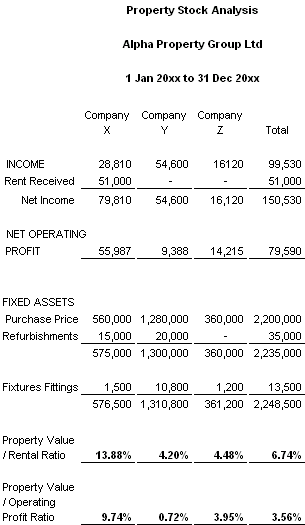Help
Group Property Company Stock Analysis
To illusrate group property company stock analysis we will use a fictious property company group called The Alpha Group of Companies Ltd. The Alpha Group has three companies which are Company X, Company Y and Company Z with each having its own property portfolio.
By combining group company Alpha's group company profit and loss statement and its group company balance sheet we are able to do property stock analysis for all its companies. Property stock is based on the purchase price of a property and the cost of any refurbishments. The costs of fixtures and fittings is generally not included unless these costs are significant.

Property Value to Rent/Sales Ratio
company X, has a property stock worth $575,000 which generates a rental/sales income of $79,810 or 13.88% of its value
company Y, has a property stock worth $1,300,000 which generates a rental income of $54,600 or 4.20% of its value
company Z, has a property stock worth $360,000 which
generates a rental income of $16,120 or 4.48% of its value
The total ratio for all companies is 6.74%
Property Value to Operating Profit Ratio
company X's property stock of $575,000 generates an operating profit of $55,987 or 9.74% of its value
company Y's property stock of $1,300,000 generates an operating profit of $9,388 or 0.72% of its value
company Z's property stock of $360,000 generates a rental income of $14,215 or 3.95% of its value
The total ratio for all companies is 3.56%. This does not consider any overheads.
Capital Asset Pricing Model (CAPM)
These figures have implications for group company Alpha's Capital Asset Pricing Model (CAPM). If the percentage return of a risk free investment such as a government bond is 4% then company X's property portfolio would be a viable investment as it generates 13.88%
in property value to rent/sales ratio. However, this figure will decrease next year due to the sale of one company X's properties. Company X's property value to rent/sales ratio would also fall for the same reason. The situation is different for company Y's property portfolio which, though having a lower property value to rent/sales ratio of 4.20%, is dependent upon ongoing rental income. Nonetheless company Y's property portfolio is not viable investment as its property value to operating profit ratio is only 0.72%. Of the remaining companies, company Z's property portfolio, is in a stronger position due to its comparatively higher rent/sales ratio of 4.48% and a property value to operating profit ratio of 3.95%. However, the former is only marginally higher than a risk free investmnent of 4%. And this will be eroded when apportioning overheads.
As a whole group company Alpha's property stock gives a higher return over risk free investment at a property value to rent/sales ratio at 6.74%. However, the property value to operating profit ratio is lower at 3.56%. Even this will not be sustained as one of company X's properties has been removed from the property stock. In sum, group company Alpha's property investment portfolio is in need of restructing to compare favourably with risk free investments.
Related Topics
Group Property Company Profit and Loss Statements
Group Property Company Balance Sheets
Property Company Profit and Loss Statements
Property Company Balance Sheets
Property Stock Analysis
|
